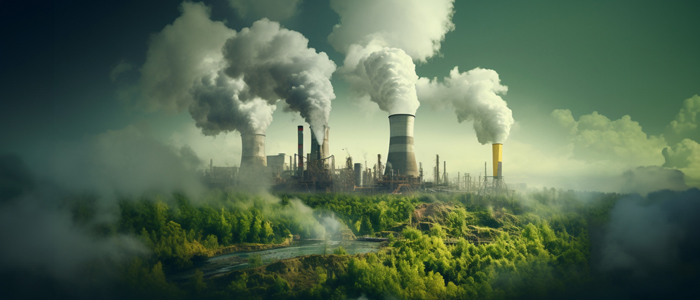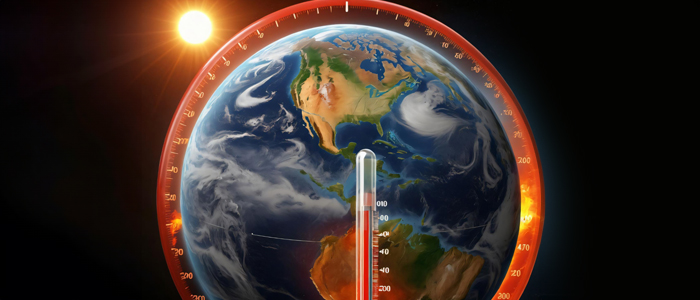
Let’s understand the science behind the climate change. Here, I am making an attempt to draw attention to the connections between Science, Technology, Engineering, and Mathematics (STEM) and the pressing challenges of sustainability and climate change.
Understanding Climate Change: A Call to Action
The Global Impact of Rising Temperatures, At the core of the climate change crisis lies a significant and alarming phenomenon: the steady rise in global temperatures. This planetary fever, driven by human activities, has far-reaching consequences that touch every corner of our world.
1. Amplifying Heatwaves: Rising temperatures are not just about a warmer day; they manifest in the intensification and increased frequency of heatwaves. Long periods of extreme heat once thought to be relatively uncommon are becoming increasingly frequent and pose significant health and environmental hazards to humans and agricultural systems alike.
2. Impact on Ecosystems; Ecosystems, intricate systems of interconnected life, are finely tuned to specific temperature ranges. As temperatures rise, the delicate balance within these ecosystems is disrupted. Species distribution shifts, biodiversity is threatened, and ecosystems face challenges in adapting to the changing conditions.
4. Altered Weather Patterns: The intricate dance of weather patterns is disrupted as global temperatures rise. Changes in temperature differentials influence jet streams and atmospheric circulation, leading to more unpredictable and extreme weather events. Storms, droughts, and floods become not only more frequent but also more severe.
5. Threats to Agriculture and Food Security: Agriculture, a cornerstone of human survival, is profoundly sensitive to climate and sustainability conditions. The warming climate and sustainability pose risks to crop yields, disrupt growing seasons, and increase the prevalence of pests and diseases. The ramifications extend to global food security, impacting communities that rely on agriculture for sustenance.
Understanding the Mechanisms: Greenhouse Gases and the Heat Blanket with vinzglobal
To comprehend the global impact of rising temperatures, it’s crucial to grasp the mechanisms that drive this warming trend. Human activities, notably the burning of fossil fuels and deforestation, release greenhouse gases into the atmosphere. These gases, including carbon dioxide (CO2) and methane (CH4), act like a heat-trapping blanket, preventing the Earth’s heat from escaping into space.
Greenhouse gases act as a natural thermal blanket for our planet. When sunlight reaches the Earth, some of it is absorbed by the surface and warms the planet. The Earth then radiates this absorbed energy back into space in the form of infrared radiation. Greenhouse gases in the atmosphere play a crucial role in trapping a portion of this outgoing infrared radiation, preventing it from escaping into space. This retention of heat creates a warming effect known as the greenhouse effect.
The Role of Specific Greenhouse Gases: CO2 and CH4
Carbon Dioxide (CO2):
Abundant and Persistent: CO2 is the most prevalent greenhouse gas emitted through human activities, primarily from burning fossil fuels, deforestation, and industrial processes.
Long Atmospheric Residence: Once released into the atmosphere, CO2 can linger for centuries, contributing to a long-term impact on the greenhouse effect.
Enhanced Warming Potential: While CO2 is not the most potent greenhouse gas on a molecule-to-molecule basis, its sheer abundance makes it a major contributor to enhanced warming.
Methane (CH4):
Potent but Transient: Methane is a more potent greenhouse gas than CO2 on a molecule-to-molecule basis, but it is present in lower concentrations.
Short Atmospheric Lifetime: Compared to CO2, methane has a relatively short atmospheric lifetime, persisting for about a decade before breaking down into other compounds.
Key Sources: Methane emissions result from activities such as livestock digestion, rice cultivation, fossil fuel extraction, and landfill decomposition.
Implications for the Planet’s Overall Temperature

1. Warming Trend: The enhanced greenhouse effect, driven by increased concentrations of greenhouse gases like CO2 and CH4, contributes to a warming trend on Earth. Human activities, especially the burning of fossil fuels, have significantly elevated the concentrations of these gases in the atmosphere.
2. Climate Change Impact: The consequences of this warming trend are observed in climate change patterns globally. Rising temperatures lead to shifts in weather patterns, more frequent and severe heat waves, alterations in precipitation, and changes in ecosystems.
3. Melting Ice and Rising Sea Levels: As temperatures rise, polar ice caps and glaciers melt at accelerated rates, contributing to rising sea levels. This phenomenon poses threats to coastal regions, island nations, and low-lying areas, impacting millions of people.
4. Extreme Weather Events: The warming atmosphere influences the frequency and intensity of extreme weather events. Hurricanes, droughts, floods, and wildfires are becoming more severe, causing widespread destruction and human suffering.
5. Impact on Biodiversity: Changes in temperature and weather patterns disrupt ecosystems, leading to shifts in species distribution, loss of biodiversity, and threats to the delicate balance of natural habitats.
A Call to Understanding and Action
Connecting the Dots: Our Individual and Collective Impact
As we absorb the scientific intricacies, it’s crucial to recognize the role each one of us plays in this interconnected story. From the choices we make in our energy consumption to advocating for sustainable practices, our individual actions collectively contribute to the broader narrative of climate and sustainability change.
The Call to Action: Recognize the power of individual choices. Advocate for sustainable practices in daily life, from energy-efficient habits to supporting environmentally conscious initiatives. Our collective impact is greater than the sum of its parts.
The Urgency of Proactive Measures: Understanding the science behind climate change is not merely an intellectual exercise; it’s a call to action. The urgency of proactive measures cannot be overstated. We explore how being informed empowers us to make sustainable choices, whether in our personal lives or within our professional spheres.
The Call to Action: Translate knowledge into action. Actively seek and support sustainable alternatives in everyday life. Advocate for policies and practices that promote sustainability. In the professional realm, explore and implement eco-friendly technologies and practices.
Paving the Way to a Sustainable Tomorrow with Vinz Global

As I conclude the exploration into the profound impact of rising temperatures and the science behind climate change, it is clear that the journey toward a sustainable future requires innovation, collaboration, and unwavering commitment. At Vinz Global, we don’t just observe these challenges; we actively engage in creating solutions that pave the way for a resilient and sustainable tomorrow.
Our commitment extends beyond technology; it is a shared responsibility to champion sustainable practices. Vinz Global stands as a dedicated partner for businesses that prioritize sustainability, offering tailored solutions to address the complex challenges posed by a changing climate. Together, let’s build a future where businesses thrive, ecosystems flourish, and communities prosper in harmony with our planet.
Join us on this transformative journey towards a #VinzSustainableFuture. Together, we can turn challenges into opportunities and shape a world where sustainability is not just a goal but a reality.
More info reach to us : vinz.sales@vinzglobal.com
#VinzGlobal #SustainableSolutions #ClimateAction #climateandsustainbility

